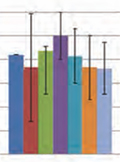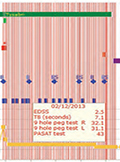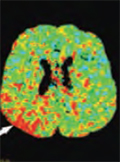The eLitMed.hu medical portal uses computer cookies for convenient operation. Detailed information can be found in the Cookie-policy.
Clinical Neuroscience - 2017;70(07-08)
Content
[Guidelines for the treatment of traumatic brain injury - 2017]
[Traumatic brain injury (TBI) is recognized to be the main cause of death and disability in the first four decades representing a major socio-economical problem worldwide. Recent communications revealed a particularly worrying image about the quality of care for TBI in Hungary. For any improvement a systematic approach characterized by utilization of scientific evidence based guidelines forming the basis for close monitoring of the actual care are considered a prerequisite. In Hungary the first evidence based guidelines in the field of TBI have been issued by the National Society for Anesthesiology and Intensive Care more than two decades ago followed by joint guidelines of the Hungarian Neurosurgical Society and the Hungarian College of Neurosurgeons. These publications were primarily based on the work of the European Brain Injury Consortium as well as guidelines issued by the Brain Trauma Foundation. Recent renewal of the latter and a need to refresh the outdated national guidelines was met by a call from regulatory authorities to issue the updated version of the Hungarian TBI-guidelines. The present review is aimed to briefly summarize the most fundamental elements of the national head injury guidelines that would hopefully be officially issued in a far more detailed format soon.]
[Calcium ion is a common denominator in the pathophysiological processes of amyotrophic lateral sclerosis]
[Amyotrophic lateral sclerosis (ALS), the most frequent motor neuron disease is characterized by progressive muscle weakness caused by the degeneration of the motor neurons in the spinal cord and motor cortex. However, according to the recent observations, ALS is a rather complex syndrome which frequently involves symptoms of cognitive impairment. Therefore, ALS cases can be interpreted in a clinico-pathological spectrum spanning from the classical ALS involving only the motor system to the fronto-temporal dementia. The progression of the disease, however, manifested in the degeneration of the upper and lower motor neurons, is based on the same complex pathobiology. The main elements of the pathomechanism, such as oxidative stress, excitotoxicity, immune/inflammatory processes and mitochondrial dysfunction are well described already, which operate in orchestrated way and amplify the deleterious effect of each other. It is assumed that calcium ions act as a catalyst in this interaction, hence each of the individual mechanisms has strong, positive and reciprocal calcium dependence thus may combine the individual pathological processes into a unified escalating mechanism of neuronal destruction. This review provides an overview of the role of calcium in connecting and amplifying the major mechanisms which lead to degeneration of the motor neurons in ALS. ]
[Valproate in the treatment of epilepsy and status epilepticus]
[According to Hungarian guidelines, valproate - with the exception of infants and small children as well as fertile women - is the first drug of choice in generalized and unclassified epilepsies because it is effective in most seizure types and epilepsy syndromes. It is highly effective in juvenile myoclonic epilepsy. Even though it is not the first-line drug in focal epilepsies, if the first-line therapy is ineffective, it is a plausible alternative as second choice therapy, owing to its different mechanism of action. If the type of epilepsy can’t be surely established, valproate is the drug of choice, as it possesses the broadest-spectrum among antiepileptic drugs. After administration of benzodiazepines, intravenously applied valproate can be a first choice therapy in all types of status epilepticus, owing to its broad-spectrum and efficacy. Valproate is the first-choice therapy in patients with glioblastoma - independently of the seizure type -, as it is likely to improve the survival rate with 2-10 months and the effectivity of chemo- and radiotherapy. Valproate is generally not suggested for fertile women, but - as it is the most effective therapy in some epilepsy syndromes -, the patient has the right to choose valproate therapy, thus undertaking the elevated risk of developmental abnormalities, for higher safety regarding seizures. If only valproate therapy owns the ability to obtain seizure freedom, then stopping its administration is not suggested, but a low dosage has to be aimed (500-600 mg/day, but not more than 1000 mg/day): according to some studies, most idiopathic generalized epilepsies can be controlled by low valproate dosage. Stopping valproate therapy in case of an ongoing pregnancy is not suggested. ]
Validation of the Hungarian version of the Test Your Memory
Concerns regarding the projected prevalence of Alzheimer’s disease (AD) over the next several decades have stimulated a need for the detection of AD in its earliest stages. A self-administered cognitive test (Test Your Memory, TYM) is designed as a short, cognitive screening tool for the detection of AD. Our aim was to validate the Hungarian version of the Test Your Memory (TYM-HUN) test for the detection of AD. The TYM-HUN was applied in case of individuals aged 60 years or more, 50 patients with AD and 50 healthy controls were recruited into the study. We compared the diagnostic utility of the Hungarian version of the TYM in AD with that of the Mini-Mental State Examination (MMSE). The sensitivity and specificity of the TYM-HUN in the detection of Alzheimer’s disease were determined. The patients with AD scored an average of 15.5/30 on the MMSE and 20.3/50 on the TYM-HUN. The average score achieved by the members of the healthy control group was 27.3/30 on the MMSE and 42.7/50 on the TYM. The total TYM-HUN scores significantly correlated with the MMSE scores (Spearman’s rho, r=0.8830; p<0.001). Multivariate logistic regression model demonstrated that a one-point increase in the TYM score reduced the probability of having AD by 36%. The optimal cut-off score on the TYM-HUN was 35/36 along with 94% sensitivity and 94% specificity for the detection of AD. The TYM has a much wider scoring range than the MMSE and is also a suitable screening tool for memory problems, furthermore, it fulfils the requirements of being a short cognitive test for the non-specialists. The TYM-HUN is useful for the detection of Alzheimer’s disease and can be applied as a screening test in Hungarian memory clinics as well as in primary care settings.
[Is second-line immunomodulatory treatment effective in multiple sclerosis?]
[Purpose - Natalizumab is the first evidence based monoclonal antibody, which was launched for treatment in relapsing remitting multiple sclerosis in Hungary in 2010. Standardized follow-up is required to use it. Our aim was to evaluate the efficacy and to monitor the safety of natalizumab treatment by using an electronic database established for MS registry. Clinical activity was measured by annual relapse rates, functional status of patients measured by EDSS and MFSC. Radiological activity was evaluated by standard MRI protocol. Data, results of MS patients and side effects of natalizumab treatment were recorded in iMed software. Results - 31 patients started the natalizumab treatment after 6.5±5.8 years from the onset of MS. The efficacy of treatment was evaluated after a mean of 67 (min: 14 max: 128) infusions in December 2016. The drop-out rate was low, due to the presence of neutralising antibodies in one case, pregnancy in two cases and development of malignant disease in one case which was not related to the natalizumab treatment. The treatment was well tolerated with excellent compliance without serious side effects. The annual relapse rate reduced from a mean of 1.7 to 0.03 (p<0.000001) in the first 12 months of treatment compared to the pretreatment 12 month activity, and it stayed at low level during the whole follow up. EDSS was stable or improved with an exception of two cases. In 23 subjects (77%) lack of new/enlarging T2 lesions and lack of gadolineum-enhancing lesions on MRI were observed. 18 patients (60%) had no evidence of disease activity (NEDA-3). PASAT test improved in most of the cases. Conclusion - The natalizumab therapy was very effective in all cases including those patients who had active disease under the previous immunomodulatory treatment.]
[Systemic thrombolysis after the administration of idarucizumab in acute ischemic stroke]
[Introduction - Expanding indications have resulted in an increasing number of patients taking novel oral anticoagulants, posing a major treatment dilemma in acute ischemic stroke. Case presentation - We present a successful intravenous thrombolysis in a dabigatran-treated patient with acute ischemic stroke after the administration of idarucizumab. Discussion - According to current guidelines, systemic thrombolysis is contraindicated under treatment with novel oral anticoagulants (taken within 48 hours). In this scenario, idarucizumab offers a solution by reversing the anticoagulant effect of dabigatran. Conclusion - Although there have only been case reports published so far, the dabigatran-antidote idarucizumab seems to give new therapeutic opportunities in the treatment of acute ischemic stroke.]
1.
Clinical Neuroscience
[Headache registry in Szeged: Experiences regarding to migraine patients]2.
Clinical Neuroscience
[The new target population of stroke awareness campaign: Kindergarten students ]3.
Clinical Neuroscience
Is there any difference in mortality rates of atrial fibrillation detected before or after ischemic stroke?4.
Clinical Neuroscience
Factors influencing the level of stigma in Parkinson’s disease in western Turkey5.
Clinical Neuroscience
[The effects of demographic and clinical factors on the severity of poststroke aphasia]1.
2.
Clinical Oncology
[Pancreatic cancer: ESMO Clinical Practice Guideline for diagnosis, treatment and follow-up]3.
Clinical Oncology
[Pharmacovigilance landscape – Lessons from the past and opportunities for future]4.
5.








